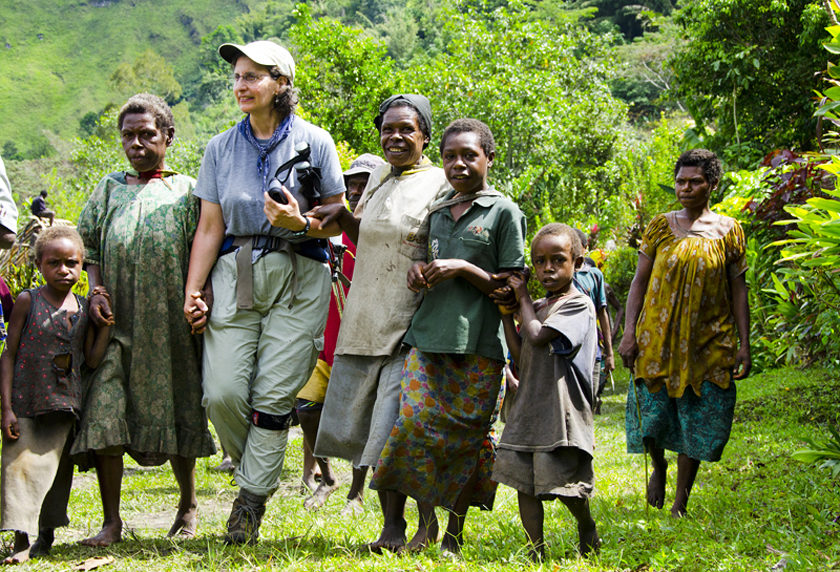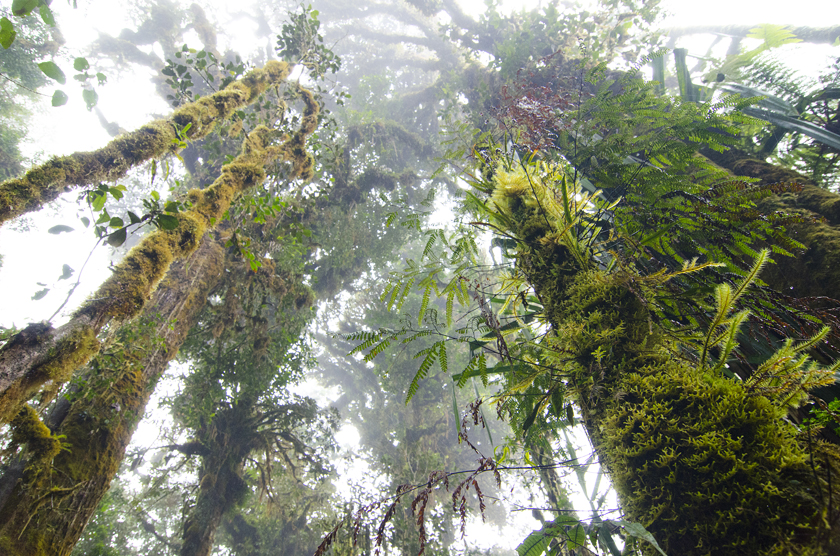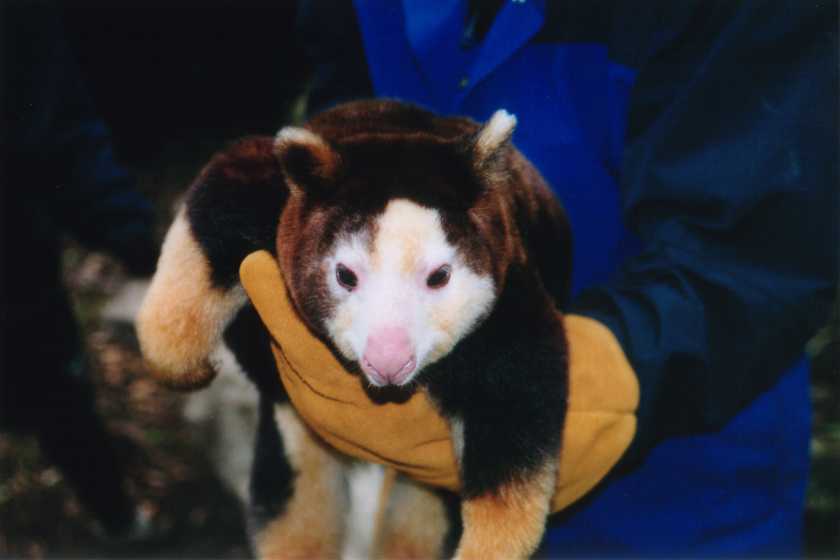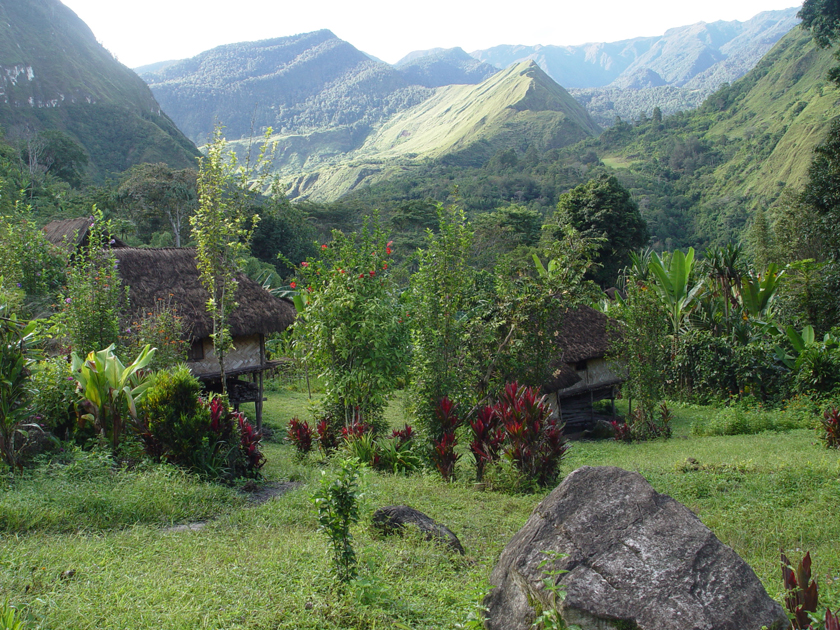Treetop Kangaroos? Who Knew?
After 18 years of patient study, of course Lisa Dabek knew, but she never really saw exactly what they were up to …until now.
By Vicki Croke
Tree Kangaroo expert Dr. Lisa Dabek says the adorable, well-furred marsupials almost look like little bears. Photo: Tree Kangaroo Conservation Project.
For 18 years, the very patient and determined field biologist Lisa Dabek has been traveling to Papua New Guinea to study the mysterious Matschie’s tree kangaroo. These kangaroos, unlike the better-known ones who hop around on the ground, live most of their lives 100 feet up in inaccessible, moss-covered trees in a cloud forest. So, Dabek’s sightings have consisted mostly of a flash of a long tail here, a few claw marks on bark there.
While for years, the work of filling in a portrait of this species had been excruciatingly slow, even with the help of local hunters-turned-colleagues, in 2009, Dabek’s study rocketed forward. It was a leap so revelatory that it made her cry.

A lightweight CritterCam provided by National Geographic, and worn by two of the tree kangaroos in her study area, was a game changer. It lifted Dabek’s view from the low, brushy base of the trees right up to the top of the forest canopy. A tree kangaroo’s eye view. It was like seeing this mountainous corner of the world—once so familiar— for the very first time.
In camp, while viewing the footage with the local men she works with, she says, “I started crying because it truly was the first time—it was a window into their world.” She was “finally able to see, she says, “oh, this is what they do. This is how they move on these small branches 100 feet off the ground.”
Dabek once spent five weeks at camp only seeing two Matschie’s tree kangaroos–one briefly and one for less than an hour. This video shows a little bit of how the CritterCams from National Geographic have changed that experience. (Notice that the tree kangaroos don’t have to be darted.) Video courtesy of National Geographic/YouTube.
She observed details of this largely solitary kangaroo species’ life: eating, climbing, and even, in the case of one female marsupial, conducting a little cleaning of her pouch, which contained a joey, or baby kangaroo.
Of course, it made her eager to see more. And this Tuesday, Dabek will arrive at camp for her second, more amped-up round of CritterCamming, which will include wider-angle cameras with smaller and longer lasting batteries.
From dawn to dusk, the cameras will videotape every two hours for 15 minutes. An exciting prospect.
And it’s a particularly exciting time for Dabek. She’s built not only an important study of tree kangaroos, all these years, but also a community-based approach to conservation that is so winning, governments and NGOs want to emulate it.
A big part of Dr Lisa Dabek’s success has been her deep, longstanding relationships with people in the YUS Community. Photo: Ryan Hawk/Woodland Park Zoo.
As director of the Tree Kangaroo Conservation Project, Dabek has quietly and steadfastly formed friendships and alliances with the people who live in the forest villages, and, in partnership with them, worked toward not just preserving the Matschie’s tree kangaroo, but also helping to provide significant healthcare to people, improving schools, empowering residents, and facilitating the decision making of the elders of local clans (who are the landowners here).
The rust-colored coat of the tree kangaroos helps them blend in with the moss of the cloud forest canopy. Photo: Russ Mittelmeier.
She has helped preserve 187,000 acres of YUS conservation land, and set up a locally-run conservation group. National Geographic and the United Nations have been among the groups recognizing her work. And now, just this summer, Dabek has been nominated for the prestigious 2016 Indianapolis Prize. (If she wins, she would only be the second woman to do so.)
The cloud forest: The kangaroos’ home is at the top of trees 100 feet tall that grow on mountains 10,000 feet high. Photo: Ryan Hawk/Woodland Park Zoo.
I interviewed Lisa Dabek 12 years ago when she was based at the Roger Williams Park Zoo in Rhode Island, and I was a staffer at the Boston Globe. She struck me then, as now, as an astute, hard-working, and kind person who would never toot her own horn. In fact, I’m not sure she has a horn. So, as Dabek packed her bags in Seattle, we asked her about her expectations for her latest field trip, about her mission to save tree kangaroos, and about the traits she shares with her study species.
What do you hope to accomplish in the field on this trip?
Tree kangaroos tend to be crepuscular [most active around dawn and dusk]. We’ve learned from the CritterCam before and from other studies that they do have activity throughout the day, but we’re trying to get a better understanding of their behavior patterns and their schedule throughout the day, and how they spend their time: When are they feeding, when are they high up in the canopy? When are they moving from tree to tree?
Basically we are just at the tip of the iceberg we really know so little.
Matschies tree kangaroos are fairly solitary. Photo: Tree Kangaroo Conservation Project.
What are you particularly curious to find out?
Sun exposure—so how often are they hidden in the canopy and how often are they on top of the trees? [Dabek guesses that big, fierce predatory New Guinea harpy eagles may keep the tree kangaroos from doing a whole lot of sunbathing.]
Why is the footage valuable?
It’s extremely valuable to have this CritterCam footage because I can’t observe the animals directly. They’re in this very thick canopy in cloud forest and so there is now way—after 18 years I still can’t observe them. You can’t acclimate these animals so this is the only way I get a handle on what they’re doing up in the trees. I’m finally able to watch their behavior—and I’m an animal behaviorist!
One concrete CritterCam observation that revealed an unknown behavior:
[The tree kangaroo eating a particular kind of orchid they were not known to eat.]
How hard has it been to track these animals?
[Very hard.] I’m envious of my colleagues who study snow leopards or cheetahs! We are still not able to use GPS collars because the canopy is so thick. We still use traditional VHF radio collars and our trackers have to go out every day.
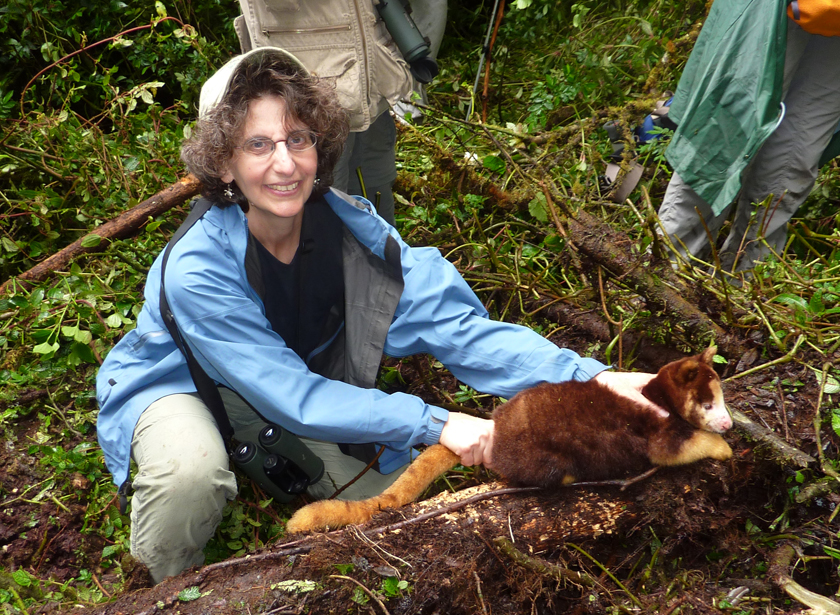
The tree kangaroos in Lisa Dabek’s CritterCam study don’t have to be darted. A team member climbs a tree and when the kangaroo leaps down, the animal is captured briefly. Photo: Bruce Beehler.
Do we know the population numbers for Matschie’s?
Probably less than 5,000 animals. They are listed as endangered by the IUCN, but there is so much pristine habitat left. We have definitely made it so they can be living forever.
How big is a Matschie’s tree kangaroo?
About the size of a raccoon or large cat.
Can you describe them physically?
The Matschie’s tree kangaroo is a wonderful combination of features. They look like little bears, they look somewhat like kangaroos, but they’re so furry. They have this thick fur because they live in the cloud forest, which is not a hot, humid tropical forest. It’s a colder forest. And their coat is this rich, orangey/cinnamon color that matches the moss and helps them hide in the canopy. Their long claws help them with gripping and climbing the trees. And they have a long tail, which helps them balance.
How about their personalities?
[Particularly because she has worked with captive Matschie’s in zoos, and has a friend who rehabilitates orphaned tree kangaroos in Australia, Dabek has gotten to know members of the various tree kangaroo species well.] They’re shy animals. The young are very curious. The males can be aggressive with each other—we’ve caught older males with scars and pieces of their ears missing—there’s less of that with the females. And they’re sweet…they seem shy but determined.
Ha! That reminds me of you!
I relate to them a bit.
A beautiful YUS village. Photo: Lisa Dabek.
Funny revelation about your beloved species:
Tree kangaroos are not the most graceful.
They do really well, but they’re not leaping from branch to branch. They have to go down, cross on the ground and then go up.
What is the scientific name for a kangaroo’s pouch?
A marsupium, and in Papua New Guinea, they call it a “pocket.”
Favorite meal in your camp in Papua New Guinea?
Taro, sweet potato, and greens. Plus, I don’t have to do the cooking.
I know you have formed close relationships with many of the people you have gotten to know over the years. Anyone you feel especially close to?
My screensaver on my computer is just bringing up some photos of my aunties! And one of them is Auntie Gosing who is in the book, [“Quest for The Tree Kangaroo,” by Sy Montgomery]… It is a joy to see her…And we will go out of our way even if I’m not working in the area where she is, so see each other. [Though men are the ones who work in the field] My Auntie Gosing has hiked many a time with me and kept me going—she’ll not let me rest too long.
Harpy eagles may menace tree kangaroos, but what do you fear when you travel there?
Malaria.
“Field Trip”: This is the first in an occasional series checking in with biologists and conservationists as they head into their study sites to begin a project.


